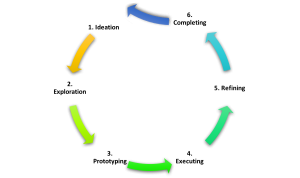The creative process is truly a process. Whether creating a symphony, a piece of art, a new product or service or an organizational initiative; both the artist, the entrepreneur and the corporate leader take the same steps. That path from idea to implementation is a long and arduous one. A journey worth taking, but one that is not for the faint of heart.
I’ve articulated six steps in the creative process – and this process is the same if you are creating art or creating a new business. In this post, I’ll state those steps followed by a simple explanation. A very simple explanation!
The goal today is to provide an overview of the process – in later posts we’ll do deeper dives. And where possible, I’ve added links to past blog posts that provides some insights that you’ll find helpful.
The steps are:

1. Ideation
In this initial step, you start with a notion that something needs to be created. It may be that you are dissatisfied with the current situation or that you have an idea that you think would work. This is an exploratory step, one in which the idea begins to take shape, where you ask many questions and explore many possibilities. The primary issue to resolve in this step is to be very clear about your “WHY” or what it is that motivates you to embark on the creative process rather than a problem solving process.
There are many ways to ideate, both as an individual and as a team. More on that in a later post!
From General to Specific
Next you will go from a general notion to a specific picture of what it is that you wish to create. I call this casting vision and doing this inside an organization is a bit trickier than casting vision for a solo effort. You must have enough specificity in the vision that you and those around you can imagine the outcome and the results. While you will not know exactly what the path is to creating the outcome, you have a sense of clarity about the outcome and the results you are wanted to bring into being.
A quick example: You know that customers are lukewarm about your service delivery. You’ve reached the limits of what can be done by merely reacting to problems faster and optimizing smaller parts of it. You KNOW it is time to create a new delivery process. At this point you have some ideas of how to do it, but none flushed out fully. However, what you do know is your WHY – all about customer satisfaction. And, you can envision in broad swaths what you want to create. Perhaps a process that cuts delivery time to 2 days rather than 2 weeks. One in which the customer knows the status of the order at all times and customers who call to congratulate rather than to complain about your process.
2. Exploration and Testing
Many of us suffer from the delusion that great things were done by people who got it right the first time. The creative process is iterative – one of taking a step, evaluating, learning, correcting course and taking another step. And then repeating this process over and over and over again. The mantra is progress, not perfection.
This is the step in which your creation begins to take shape. You explore. You see what others do. You create a long list of possibilities, pick a few and prototype them. Think of this stage as what Edison did to test thousands of filaments to find just the right one for the incandescent bulb.
This is the stage of rough ideas turned into small experiments. This is the stage of trying twenty things to get to one. This is the stage of twists and turns (or pivots), attempts and failures and rapid learning. It is the evolution of taking a possibility to a proposal.
It is also the stage at which many individuals fail to move forward. Whether due to over planning, fear, distractions or inertia, many people just cannot manage to turn their idea into reality. Moving into this step takes courage, discipline and persistence. Taking that first step, even though it may be uncertain or scary, can lead to the next step and then the next step and once again the next step.
Making It Tangible
To get tangible, let’s use our service delivery vision – to cut delivery time to two days with total transparency for the customer. You might first expand your thinking by looking at others industries or delivery models. What can you learn from FedEx? From Amazon? From the pizza delivery guy? From 3-D printing? From an emergency room?
Then you might white board three different new processes to try and do some experiments. Once you learn from those, you might enlist a few customers in a pilot program with the most promising options from those experiments.
And you will learn. You will adjust. You will abandon some ideas and embrace others. And you will repeat and repeat again – until you have something that works.
3. Executing
Armed with everything you’ve learned in your pilots, prototypes and experiments, you are now ready to launch. In organizations that might be a full blown implementation or it may be a series of smaller implementations, building over time. No matter what the implementation approach is, this is the step in the process where this idea that you have nurtured and worked on and obsessed over hits the market, the shop floor or the workforce.
This step requires a host of logistical and managerial skills. It also requires courage. For as all creatives know, this is the step where you are subject to rejection. The process that you so painstakingly labored over is met with resistance. Your brilliant new service is greeted with skepticism. That new product takes a long time to get uptake.
And so, using our example of streamlining a service delivery process, you must have the courage to launch the process, the tenacity to stay with it in spite of resistance and push back and wherewithal to continue to work through all the details of a complex implementation.
4. Refining
I can guarantee, that no matter how much thought and planning went into your new product, service or process – that there will be something that was missed. Something that is not working as planned. Some unintended upstream or downstream consequence.
The more complex your creation and the more complex the organization you create it, the more likely it will happen. Just accept the fact that you will need to refine for a period of time after launch.
Not only accept, but plan for it. Designate ways to gather feedback early and often in the beginning stages. Have resources available so that you can react to what needs changed.
What happens in this phase, if done well, is that resistance drops as people are heard. Your creation gets better and better. All your hard work has a much better chance of sustainability as it becomes a living part of the fabric of the day to day workings.
Not refining endangers the entire effort. Forcing utilization of a creation with flaws results in cynicism and even greater efforts to derail the effort. Far better to listen hard, adjust quickly and then listen some more.
And so in our service delivery example, before launch you might engage some stakeholders who are candid and influential with their peers to be on your SWOT team. Enlist them to find problems and empower them to fix the problems they uncover. Several things will happen – you’ll both improve quickly and create powerful advocates for your creation.
5. Completion
At some point, you must declare “done”. This prevents the tendency to be pulled into long series of continual tweaks that begin to add diminishing value. It allows you to focus on the next creative project. This is an especially important stage for the types of creative project that leaders embark on, as they will require engaging your team in their realization. Declaring a thing “done” and celebrating the progress does many things: frees energy to focus on other important outcomes, creates a sense of pride and accomplishment and reenergizes your team for ever greater accomplishments.
Perhaps in our service delivery example, you pull together key leaders and those that worked with you to make it happen. You walk them through the experience of the old way and then do the same with new one. You share data about the differences in delivery time and the resulting customer feedback and share creation stories about the trials and tribulations you encounter along the way. And then, you leave everyone with clear evidence that this creative journey has been one well worth taking.




